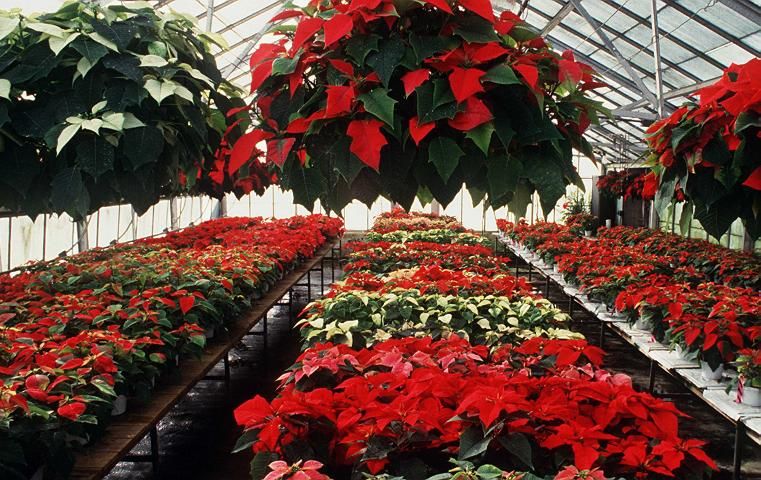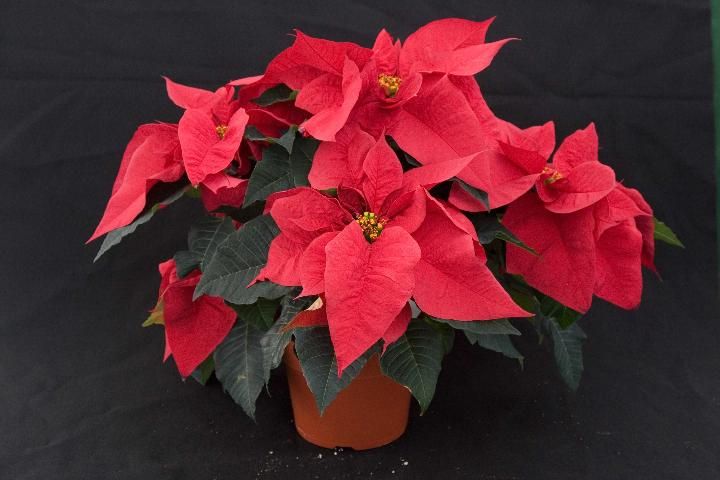The poinsettia (Euphorbia pulcherrima), well known as a decorative potted plant for the Christmas season, will perform as a Florida landscape plant where prolonged freezes are not the norm or where a warm microclimate exists around a home. This fact sheet offers basic information on growing these fascinating plants.

Credit: UF/IFAS
Lore and misconceptions surround the poinsettia; here are some interesting facts.
The poinsettia is native to Mexico, and the Aztecs used them in their fall celebrations. The plant's name is derived from Joel Poinsett, the first US minister to Mexico, who introduced the plant to the US in 1825. The colorful and showy "flower" is actually a cluster of modified leaves called bracts. The true flowers are small and clustered in the centers of the bracts.

Credit: Tyler Jones, UF/IFAS
Poinsettias are not poisonous, although some people are mildly allergic to their white, milky sap.
The poinsettia is a "short day" plant that blooms when days are short and nights are long. The extended period of darkness is the natural trigger for flowering. If the dark period is interrupted by artificial light from any source after October 1, flowering will be delayed or interrupted.
As a result of intensive breeding, the traditionally bright red poinsettia is now available in burgundy, pink, peach, white, yellow, and marbled colors.
Caring for a Potted Poinsettia
Poinsettias are tropical plants and prefer a temperature range of 65°F (night) and 75°F–80°F (day). Inside your home, keep them in a brightly lit area away from drying or chilly drafts. They will tolerate full sun on a porch or patio but must be protected from frost or freezing temperatures. Water your poinsettia only when the surface of the soil is dry to the touch. Remove any excess water from the saucer or decorative pot sleeve because poinsettias do not tolerate soggy soil. Do not apply fertilizer.
Poinsettias as Outdoor Plants
The best potted plants for establishing in the landscape are ones that have been in good light while indoors and have retained some green and healthy leaves. Choose a sunny spot that will not receive any artificial light at night. Plant your potted poinsettia(s) as soon as danger of frost is past. Cut off the fading bracts, leaving 4–6 inches of the stem on each branch and as many green leaves as possible. Poinsettias prefer moist, well-drained soils with a soil pH between 5.5 and 6.5. Place the plant in the soil at the same depth it was growing in the container. Gently firm the soil around the plant and water well. Keep the plant mulched and well-watered until established. Fertilize monthly, from March to October in central and south Florida and from May to September in north Florida. Use a fertilizer with balanced amounts of nitrogen and potassium (the first and third numbers of the analysis) and low phosphorus (the middle number). Follow the application directions on the product label. Prune in early spring when the floral display is finished and the danger of frost has passed. Cut back to within 12 to 18 inches of the ground or to living tissue if the plant was damaged by cold. Poinsettias may become "leggy" and unattractive if not pruned regularly during the growing season. Cut back once a month, if needed, leaving four leaves on each shoot. Discontinue pruning after September 10. Flower buds will begin to develop in October. Delay or disruption of flowering will occur if fall temperatures are too warm or too cold or if the required dark period is interrupted.
Troubleshooting
Magnesium Deficiency—Magnesium deficiency is a common problem with poinsettias. The symptoms are scorching on the margins and tips of the leaves and yellowing between the leaf veins. It is difficult to correct on affected leaves but can be prevented in subsequent years by applying magnesium sulfate (Epsom salts) in February/March and June/July at the rate of 3 tablespoons per square yard.
Insects and Mites—Pests that attack poinsettias include aphids, mealybugs, soft scales, whiteflies, and spider mites. The poinsettia hornworm is a particularly serious problem, since it can rapidly defoliate an entire plant. If only a few are responsible for the damage, pick off and destroy them individually rather than spraying the entire shrub.
Diseases—Poinsettia scab (Sphaceloma poinsettiae) is a fungal disease that causes circular, cream-colored spots on the midribs and veins of leaves and raised lesions on stems and leaf petioles. Scab is most prevalent in the summer, and scab-infected branches should be pruned and discarded as soon as they are noted. Plants growing in poorly drained or over-watered areas are often killed by fungi that rot the roots and stems.
For more information on diagnosing and managing problems, contact your local UF/IFAS Extension office: https://sfyl.ifas.ufl.edu/find-your-local-office/.
Interesting Websites
The Society of American Florists: https://safnow.org/aboutflowers/holidays-occasions/christmas/
Poinsettias—Holiday Color for the Home and Garden: https://gardeningsolutions.ifas.ufl.edu/plants/ornamentals/poinsettia/